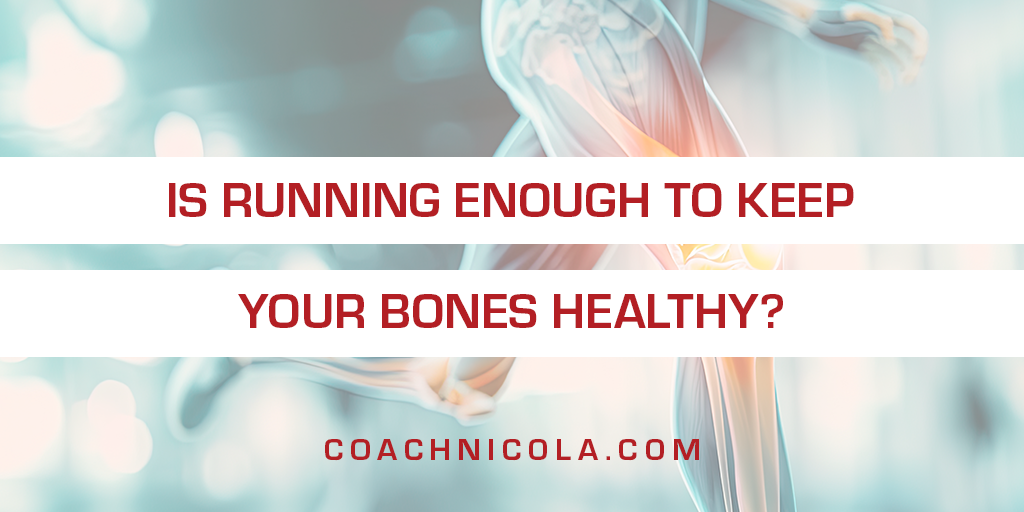Is running enough to keep your bones healthy?

Many runners know that there are some bone health benefits to running. But you might wonder if running alone is enough to keep your bones strong and healthy.
Read on to find out.
Why should I care about my bone health?
As a runner when you think about your body, your first thought might not be about your bones!
But taking care of your bone health is important for several reasons.
Firstly, strong bones are less likely to fracture or break from falls or injuries. It’s not that uncommon to trip or fall during a run – I can think of at least three memorable trips I’ve made on a run! Having strong bones will help prevent those trips turning into something more serious.
And breaks and fractures can take a while to recover from, which means time off from running. Not what we want!
Strong bones also provide the foundation for good posture, balance and co-ordination, all of which are important for running.
And having strong bones reduces the risk of osteoporosis, which could otherwise stop you from running.
Why women need to care more about their bones
If you are a female runner, bone health is even more important.
Osteoporosis affects 1 in 3 women over the age of 50 in the UK (it’s 1 in 12 for men). This difference is due to the menopause. Oestrogen helps to maintain and build bone, so when women experience a drop in oestrogen levels after menopause this affects the bones.
Making sure you are doing all you can to build and maintain your bone density, both before and after the menopause, is really important.
And the good news is, that everything you do to help your bones will help your hormonal health, brain health and may even help to reduce perimenopause and menopause symptoms.
How running helps bone health
Bone is a living organism. It has its own blood vessels and cells, it is constantly growing, breaking down and rebuilding itself.
However, the rebuilding phase starts to slow down in your 30s after you have reached peak bone density. So anything that can encourage the rebuilding phase to keep going is essential. Before your 30s to make sure your bones are as strong as possible, and after your 30s to maintain and slow down the bone density loss.
One thing that encourages this rebuilding and repair is regular weight bearing exercise such as running.
Running, and other weight bearing exercise, puts stress on the bones which stimulates the cells and hormones needed for bone building. Which helps to maintain your bone density levels.
Why running might not be enough
Although running is weight bearing, it is only weight bearing on your lower body. So running will help the strength of the bones in your legs and hips, but not your spine or wrists (two areas commonly affected by osteoporosis).
Also, the speed you run is important. There is more impact, and therefore more weight bearing, in sprinting then an easy run. Which is another reason to add those regular speed sessions to your running!
One thing you can add for more impact that also helps your running, is plyometrics. These are powerful bounds or jumps that emphasise the reactive force you need for running. You can add these are drills after your warm up.
But be warned, as plyometrics involve powerful, explosive, high intensity movements you need to the correctly to do them safely. Always start low and slow, work on technique before adding speed and power. Dr Stacy Sims has a good guide on plyometrics here.
So although running is good for bone health, it’s not the only thing you should be doing.
Bone friends
What else is good for bone health?
When we think about bone health the first thing that comes to mind is calcium. But please note, this isn’t all about dairy. If you are vegan, dairy free, or just don’t like it, then there are plenty of other sources of calcium.
And to make sure that the calcium is fully absorbed we need vitamin D, which the body produces when sunlight hits the skin. If you are a runner and outside a lot you might think that you will get enough vitamin D. But in the winter in the UK the sun isn’t strong enough, which is why the NHS recommends all adults take a vitamin D supplement during the autumn and winter months.
Resistance training can also help bone health by improving muscle mass and the load on the bones. However, this is less effective if you use a fixed weight machine. So exercises using bodyweight, resistance bands or free weights are a better choice.
Bone foes
There are also bone foes that we should be avoiding.
The biggest one is smoking as the nicotine decreases your calcium levels and slows down the production of bone building cells.
Smoking also affects your lung health, and as runners we really need our lungs to be working at their best!
The other bone foes include foods which may affect the way calcium is absorbed in our body, so are best enjoyed in moderation. And even if they don’t have a big effect on bone health, these are foods that we should be reducing for overall health such as foods high salt and sugar, alcohol, caffeine, red meat and fizzy drinks.
I hope this has given you an idea of why you should look after your bones, and what you should do as well as running to keep them strong and healthy.
And if you are stuck on how to include more bone health exercises to your running, just get in touch to see how I can help you.

Leave a Comment
(0 Comments)